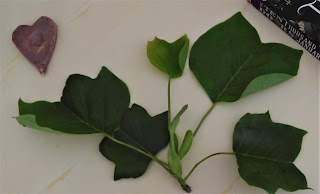He often walks to and around Lake McKinley so today's shoot took place there at the spillway. His official pic is with the lake behind him, but I chose this one (which wasn't the best of him) of the water as it comes under the roadway and out because I liked the colors. Also because it intrigues me that this is where the Platte River, which gets fairly wide before entering the Missouri River near Farley, MO, has its origin. (Okay, technically it begins on the other side of the lake where it was one of many small streams before the dam was built.)
Bud went on with his walk and I went back to this tree, here as I first photographed it April 8, because then I was stumped as to what kind of tree it was. I did not remember ever seeing winter seed pods like those before. But even with this photo and one of the tree's bark, I couldn't identify it.
I knew I had to wait for it to leaf out before I could identify it. Even then, I was at a loss.
There were a couple stems of leaves on the ground so I brought one of them home and got out my old (1952) Guide to Familiar American Trees book to finally learn the tree is a Tulip Tree! Boy, was I surprised. All my life I thought a tulip tree was just another name for the magnolia trees with their pink and white blossoms. (Note: You are never to old to learn something new.)
Here is what my tree guide says about the Tulip Tree: "TULIPTREE or Yellow-poplar is a tree of ancient lineage. Closely related to the primitive Magnolias, the Tuliptrees go back over fifty million years. Fossil leaves have been found in rocks of Europe and Greenland. The Tuliptree grows tall, its straight trunk free of branches near the ground. (If those leaves had not already been on the ground, I could never have reached them.) A beautiful tree in all seasons, it is planted as an ornamental but not as a shade tree. The peculiar squarish leaves, broad and notched, make identification easy. (It will be for me from now on!) The tree is named from the greenish-yellow tulip-like flowers, opening in May or June. Buds, closed by two purse-like scales, are unique. The fruit is a cone of many small, winged seeds. The creamy yellow wood, soft, easily worked, is used for pulp and manufactured articles."
This is a picture of an Iowa City Tulip Tree in bloom which I found online, but I will certainly go back in a week or two to take some of my own pictures of the Tulip Tree in Lake McKinley Park.





No comments:
Post a Comment